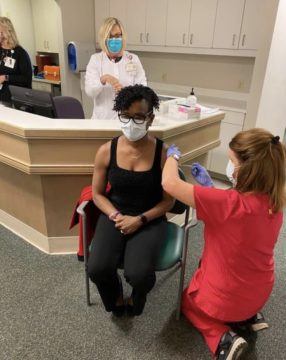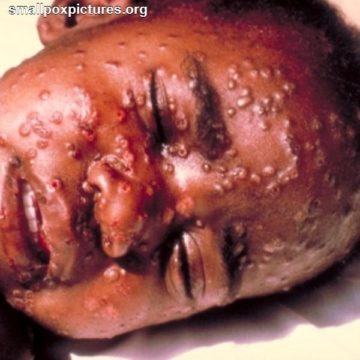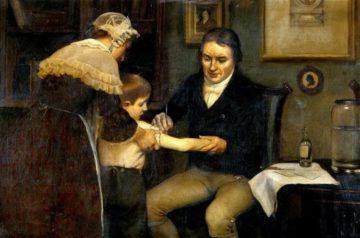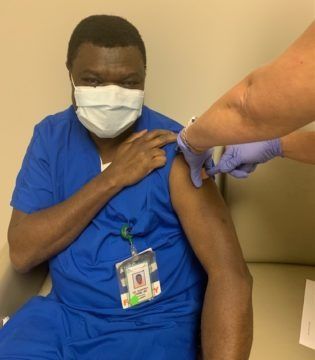by Godfrey Onime

Ponder this. It is the 15th century and you have a high chance of contracting and dying from a rampant infection. Turns out that you could intentionally infect yourself with a small dose of the contagion, get slightly sick, and become protected for life. Of course, things are not always that simple. You could get more than just a little sick. You could even die, but 1000 times less likely than if you acquired the infection naturally. Would you infect yourself and beloved family members? I believe I would, and I’ll tell you why.
Long before science knew about bacteria and viruses or that they caused diseases, long before vaccines were even imagined, that exactly was the dilemma that people the world over faced — whether or not to preemptively infect themselves, in hopes of preventing more serious illnesses, or worse, death. Indeed, those were desperate times, with no antibiotics, hospitals, or ICUs.
One vexing affliction for this historical palaver was smallpox, which was rampart in much of recorded history. Not only was it highly infectious, it rendered its victims extremely sick: raging fevers, splinting headaches, searing backaches, crippling fatigue, monstrous skin eruptions, and quite often, death. When it did not quickly and gruesomely kill sufferers, the scourge left them disfigured, not the least with unsightly pockmarks on the face. Little wonder then that many started to intentionally infect themselves and kids with smaller and possibly weaker doses of the infection, which they obtained from the oozing sores on the skins of the afflicted. This practice of using the actual, live bug to self-induce infection is called variolation. Among those intentionally exposed to smallpox through variolation, about 1-2 in 100 may die. For those who got the infection naturally, about 30 in 100 died.

The practice of variolation is believed to have originated with the Chinese, after they realized that people who survived smallpox did not become reinfected. They collected dried scabs from the lesions of those with mild illness and grounded them up. Then they blew the powdered scabs into the nostrils of those they wished to protect. For boys the powders went up the right nostril, for girls the left, because, as Jeffery Kluger puts it… well, it was the 15th century. In other cultures such as Europe, pus from the lesions of those sickened with smallpox may be collected and introduced onto scratches or small cuts made on the skin.
Variolations spread through Asia, Africa, Europe, and eventually to America by way of an African slave called Onesimus. George Washington, who had himself contracted smallpox as a child and seen many succumb to it or become severely disfigured, embraced the practice of variolation. Afraid that the British might try to use smallpox as a biological weapon during the Revolutionary War, he ordered his previously uninfected soldiers to be variolated.
In time, some began to wonder: Couldn’t there be a better way than smearing live infections onto skin cuts or blasting powdered infected scabs up the nostril? The answer: The tales of the milkmaids.
As the story goes, there once was a beautiful milkmaid with a flawless face, impeccable complexion and a confident smile. A 13-year-old orphan boy heard her brag, “I shall never have smallpox for I have had cowpox. I shall never have an ugly pockmarked face.”
The boy was Edward Jenner, who would become the 18th century British physician credited with discovering the first reliable and safer vaccine.
Intrigued by the milkmaid’s boastful declaration, Dr. Jenner had noticed that dairymaids often had blisters on their hands or skins which somewhat resembled mild forms of smallpox rash, and that they truly never acquired smallpox afterwards. In 1796 the physician embarked on a daring experiment, one that would today be frowned upon. He obtained pus from the pustules of a milkmaid and jabbed it into the arm of an eight-year old boy named James Phipps. When he later exposed the kid to smallpox, Master Phipps did not become sick. Dr. Jenner would expose the lad to the horrendous disease some 20 more times, but each time the boy shook it off like a stubborn annoyance. In fact, Master Phipps grew up to become Mr. Phipps, got married, had two children, and attended the funeral of Dr. Jenner in 1823.
Repeating the process on some 11 more children, Dr. Jenner found that his experiments worked. He published his findings in a book with the impossible title, An inquiry into the causes and effects of the variolae vaccinae: a disease discovered in some of the western counties of England, particularly Gloucestershire, and known by the name of the cow pox.
Less-than-friendly title or not, Dr. Jenner’s invention was generally well received and would save millions of lives.

How variolation worked and why Dr. Jenner’s finding was superior
Though the people did not know it then, introducing infections to a person through variolation tricked the body into making ammunition targeted to that particular bug. These ammunitions are called antibodies. Because the smallpox microbes introduced were either weakened or present in quite small amounts, the body had time to make enough of the antibodies to disarm them before they caused serious illnesses. After the contagions had been defeated, the antibodies remained in the body, patiently waiting and watching, sort of like your body’s own personal secret service agents. And then, when next the bugs invade the body, possibly in larger quantities that would have been otherwise deadly, the special secret service agents burst into action and quickly crush them.
But Dr. Jenner’s stunt with the milkmaid’s pus proved more revolutionary. It happens that the dairymaids contracted a similar virus to smallpox from the cows that they milked. Called cowpox, the virus caused little or no symptoms in humans. However, the contagion could trick the body into making the special secret service agents that saw it as possibly smallpox. When an actual smallpox virus later attacked, the special antibodies sprung to life and slayed them, before they could cause disease. It’s like a snake surreptitiously sneaked into your home. Fretting and dashing about as I would have, you finally locate a shovel and chopped off its head. But there was something you did not know.
You had no clue that the snake was not poisonous — it sure seemed so. Feeling lucky to have escaped what you believed a close call, you kept the shovel in a more accessible place, ready for the next breach. And when a snake do invade your space, now a poisonous one in fact, you are ready. You dash for the shovel and decapitates it, it’s body and tail flailing in the throes of death. In fact, the name vaccines originated from Dr. Jenner’s use of cowpox for the first vaccination – from vacca (Latin for cow) and vaccinus (Latin for “from cows”). As opposed to variolation whereby the live, actual infectious agent is introduced into the body, vaccination involves using a similar, much weakened, or killed bug, or a non-infectious part of a bug. These mimics trick the body into getting ready for what might one day be a truly deadly invader — just as you had become prepared for the arrival of the poisonous slitter.
With the COVID-19 pandemic still raging, vaccines have again become a hot topic, as they seem to be among the best measures to arrest the scourge. And many are concerned about the possible safety of the newly developed vaccines, including that they were supposedly developed too fast. But was it, really? I believe not. The vaccines were built on hundreds of years of history and science — from the crude and often risky practices of snorting powdered pustular scabs, through the scientists who unlocked why it worked, to the highly researched and safer vaccines of today.
In fact, vaccination always had its critics, dating back to Dr. Jenner’s milkmaid discovery in the 1700s. Some objected to intentionally injecting humans with animal diseases. Others conjured up satires of people growing cows arms or other parts. Yet, some conservative clerics argued that vaccination aimed at preventing ailments went against God’s will. They proposed that God gave us diseases such as smallpox and the plagues as trials so that our souls can be worthy of salvation. The skepticism concerning vaccination have only intensified over the years, thanks to partisan news outlets and conspiracy-spawning social media, resulting in sketchy opinions and half-backed lies drowning out sound sciences.
Not to say I object to everyone who questions vaccines. Far from it. I believe it’s okay to question not just vaccines, but science in general. Science is about discourses and understanding. In fact, questioning science spurs progress, help scientists improve their work. And improved have vaccines become over the years — thanks to better understanding of infective agents, the immune system, and subsequently, molecular biology and genetics.
The next giant leap in vaccines science
While Jenner struck gold with finding the cowpox relative of the virulent human smallpox, nature is often not so neat. There are not always cousins of contagions less deadly to humans that can be readily found in other animals. And even when infections go from animals to humans, they can be more disastrous to us than they were to the beast itself. For instance, the current virulent coronavirus that causes COVID-19 is thought to have originated from bats.
Science owes the next major sprint in the science of vaccination to the French biologist Louis Pasteur nearly 100 years after Jenner’s discovery. After elucidating that microbes did indeed cause diseases, Pasteur successful developed vaccines against anthrax in 1881 and rabies by 1886. He achieved these by weakening the pathogens so that they could no longer cause infections; however, they still were able to rev up the body’s secret service agents, or antibodies, against future actual infections. Other scientists soon followed, discovering safe and effective vaccines against tuberculosis, measles, mumps and rubella, polio, and a host of other contagions. Some even employed killed viruses to eliminate the chances of inducing infections in, say, those with weakened immune systems, such as from HIV or chemotherapy. And by the 1940s and beyond, scientists further began to use just pieces of the pathogens to train the body’s immune police.
There have been more miracles to come. Recent decades have rewarded scientists with the ability to harness the parts of the DNA or mRNAs of bacteria and viruses that do not cause illnesses, and then have the body make proteins from them. These proteins are able to stimulate our immune systems to recognize and disarm the actual pathogens should they strike. The COVID-19 vaccines by Moderna and Pfizer have richly benefited from these research and hence allowed for a relatively quick development of safe vaccines.
You may question science, but do so responsibly
I’ll say this again: It’s okay to question vaccines — and science in general. Throughout college, medical school and residency, we were trained to do just that, and I still do it today. I also encourage my medical students and residents to do the same. We challenge our researcher-colleagues, push them to think harder, to do better. But when they can satisfy us, we accept their findings. We questioned because we truly wished to learn.
So it should be with the COVID-19 vaccines. Before deciding whether to receive the vaccine, I did my due diligence. I read the research, rather than Facebook memes or conspiracy blog posts; I pondered the findings and listened to the experts, rather than to friends or celebrities who knew not the first thing about science. Feeling reasonably confident with the vaccine, I said a silent prayer to the brave men and women who put themselves on the line and participated in the original studies, when they knew not if the vaccines would work or how safe they were. Then I marched to my hospital clinic, rolled up my sleeve, and allowed a nurse to jab a needle into my arm and infuse the life-saving vaccine. And as Dr. Obiefuna Okoye, MD, MPH, an infectious disease specialist at my hospital, UNC Health Sountheastern — and first to receive the vaccine in my county — joked about his experience, “I have not developed an extra eye yet.”

Vaccinations save lives, period
Vaccines must not be taken for granted. Yes we ought to question science, but in order to truly learn. And we must be careful to whom we listen. The Italian physician and microbiologist, Roberto Burioni, is quoted as saying, “Does an aircraft engineer take a vote among the passengers as to how many wheels to put on an airplane? No—the engineer is the expert… and it’s his job to decide.” Just as we would not board a plan that’s flown by our untrained friends or favorite celebrities, we should be careful to only get our vaccines facts from reputable sources and trusted scientists, and not from celebrities like Jenny McCarthy, who quipped on Oprah that she learned her biology “from the university of Google.” The simple truth is that vaccines save lives, and they are safe, including the current COVID-19’s iterations. Or to again quote Dr. Burioni “The Earth is round, gasoline is flammable, and vaccines are safe and effective. All the rest are dangerous lies.”
In our increasingly precarious world, new pathogen are sure to erupt and claim precious lives, particularly when we fail to prepare for them. Hopefully we can continue to better and better harness the incremental progress in science over the years, make safer vaccines faster, and save more lives. But we have to take the vaccines. There just is no getting around that fact.
